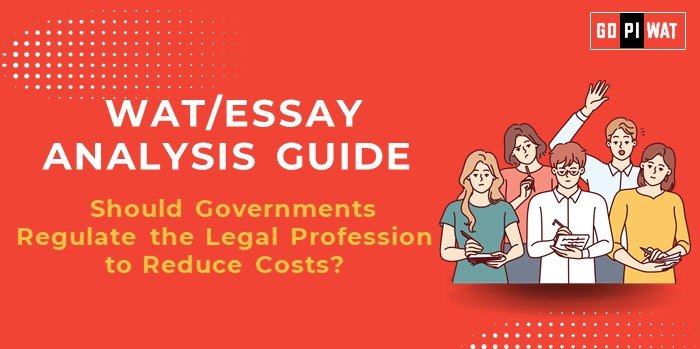📋 Written Ability Test (WAT) Analysis Guide: Should Governments Regulate the Legal Profession to Reduce Costs?
🌐 Understanding the Topic’s Importance
The debate on government regulation in the legal profession touches on access to justice, economic fairness, and market efficiency. Rising legal costs often restrict access for marginalized communities, making this a critical issue for policymakers, legal practitioners, and society.
📝 Effective Planning and Writing
- ⏱️ Time Allocation:
- Reading & Planning: 5 minutes
- Writing: 20 minutes
- Review: 5 minutes
- 📋 Preparation Tips:
- Research case studies on legal aid reforms and capped-fee structures.
- Note key arguments from global comparisons such as the UK and Australia.
🎯 Introduction Techniques for Essays
- ⚖️ Contrast Approach: “While legal systems aim for justice, skyrocketing costs often leave marginalized communities without recourse.”
- 🔧 Solution-Based Approach: “Introducing regulations like fixed-fee structures could balance cost and quality in legal services.”
- 📜 Timeline Approach: “From laissez-faire markets to regulated industries, the legal profession faces a critical juncture in addressing affordability.”
📊 Structuring the Essay Body
1. Achievements:
- 📜 The UK’s capped-fee system reduced costs and improved access to justice.
- ⚖️ India’s legal aid initiatives, under the Legal Services Authorities Act, have benefited millions.
2. Challenges:
- 🚫 Resistance from the legal community fearing loss of autonomy and income.
- ⚠️ Risks of declining service quality if regulations prioritize cost reduction over expertise.
3. Future Outlook:
- 💻 Leverage technology for affordable, scalable legal services, such as Estonia’s e-governance platforms.
- 🤝 Foster public-private partnerships to expand legal aid reach.
- 📚 Implement training programs to balance quality and cost in legal practice.
📖 Concluding Effectively
- ⚖️ Balanced Perspective: “Regulating the legal profession is a step toward equity but requires safeguards to maintain service quality.”
- 🌍 Global Comparison: “Countries like Australia show that combining regulation with legal literacy and funding can improve justice delivery.”
🔍 Analyzing Successes and Shortcomings
Key Achievements:
- ✔️ Reduced costs in regulated jurisdictions.
- 📈 Increased penetration of legal aid programs in countries like Canada.
Ongoing Challenges:
- 🚧 Uneven implementation of reforms across regions.
- 💻 Lack of digital access in developing nations hampers scalability.
Global Context: Estonia’s e-governance and Canada’s subsidized legal aid serve as benchmarks for effective legal reforms.
💡 Recommendations for Sustainable Progress
- 📶 Invest in digital legal platforms for wider access and cost efficiency.
- 🤝 Encourage public-private partnerships to improve funding and expertise.
- 💸 Provide targeted subsidies for economically weaker sections to ensure inclusivity.
📄 Sample Short Essays
1. Balanced Perspective: “Governments must regulate the legal profession to reduce costs, ensuring access to justice. However, such measures must be balanced with efforts to maintain quality and foster innovation.”
2. Solution-Oriented: “Fixed-fee systems, technology integration, and increased funding for legal aid are essential to making legal services affordable.”
3. Global Comparison: “While regulation has worked in the UK and Canada, other nations must adapt such models to local contexts, ensuring broad and inclusive access.”


